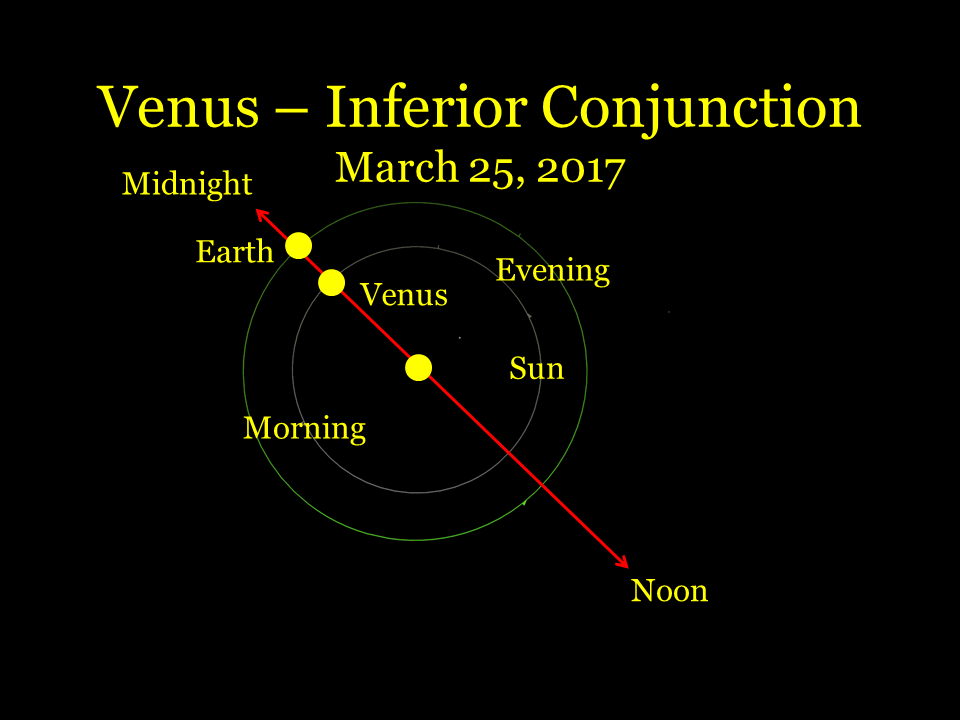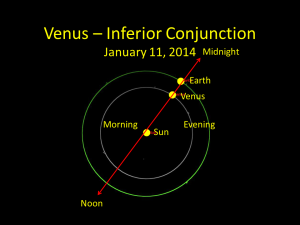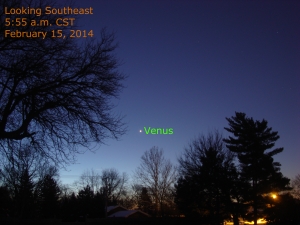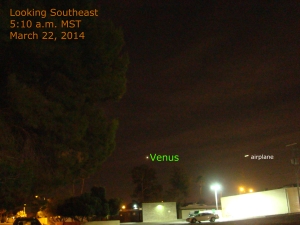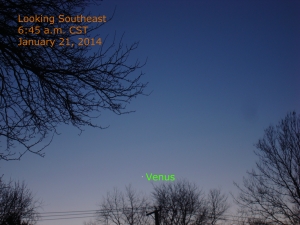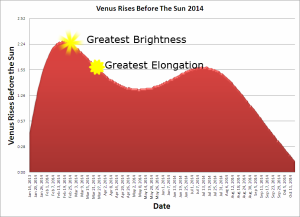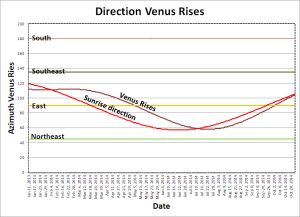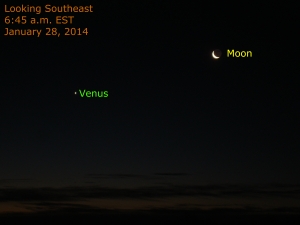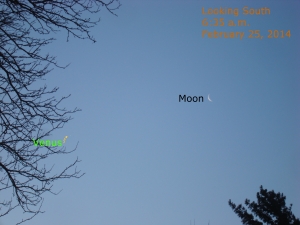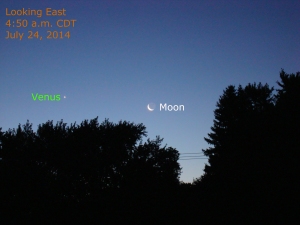This appearance of Venus concluded October 15, 2014, when it passed superior conjunction and moved into the evening sky.
Venus makes an appearance in the morning sky, displaying its gleaming “Morning Star” brilliancy throughout most of 2014. Venus enters the eastern morning sky in late January 2014 after passing between Earth and Sun (inferior conjunction). (Click all images to see them larger.)
At inferior conjunction on January 11, 2014, Venus is a scant 24.8 million miles from our planet; that’s about 100 times the distance to the moon. Even though the three celestial bodies are aligned, the alignment is not perfect, as Venus is about 5 degrees north of the sun, rising 30 minutes before the sun at the conjunction. (See the chart below showing the difference between sunrise and Venus rise.)
Times are on the diagrams to show the times of noon and midnight. Additionally the morning side of the sky is distinguished from the evening planets. These times are referenced from our planet. Notice that we never see Venus in the midnight sky. (The midnight arrow never points at or goes through Venus.)
Within a month as it rapidly moves higher in the eastern morning sky, Venus reaches its greatest brightness outshining all other starlike celestial objects on February 15.
In late March, Venus reaches its greatest angular separation from the sun, known as greatest elongation west. It is west of the sun, rising about 2 hours before the sun in the eastern sky. When facing the eastern predawn sky, Venus appears to the right of the growing daylight; that’s west of the sun, yet it appears in the eastern sky. Similar seemingly word trickery is used when Venus is an Evening Star.
The first image captured during Venus’ 2014 morning appearance as seen from the Chicago area.
Venus continues to shine in the eastern sky. The moon passes it 9 times. Venus passes several brighter stars and Jupiter. Venus rapidly moves from Earth, dimming, yet incredibly brilliant.
By early autumn it rises during bright twilight disappearing behind the sun for superior conjunction on October 25.
The chart above shows the difference between the rising times of the sun and Venus from data from the U.S. Naval Observatory. As noted above, even at conjunction Venus rises 30 minutes before the sun as it is north of the sun at this time. Notice how rapidly Venus moves into the evening sky as it reaches its greatest brightness. From its first appearance in late January to late April is rises before twilight begins. For the rest of its appearance it rises during twilight. Beginning in August, it rapidly moves toward the sun as it nears its superior conjunction.
This chart shows the rising point of Venus compared to the sunrise direction. Notice that Venus rises north of the sunrise point from its inferior conjunction until February 9. Until July 14, Venus rises south (to the right along the eastern horizon) from where the sun rises. After mid-July Venus again rises north (left along the eastern horizon) from where the sun rises until superior conjunction. (Data on the chart from the U.S. Naval Observatory.)
During the 2014 morning apparition, Venus appears in a part of the sky that has mainly faint stars. Below are some notable events of Venus as a Morning Star in 2014.
Appearances With Crescent Moon
- January 28, 29
- February 26
- March 27
- April 25
- May 25
- June 24
- July 24
- August 23
- September 23 (in bright twilight)
Appearances with Stars and Planets
- Mercury (19 degrees to lower left of Venus), March 14
- Aldebaran, July 1
- Mercury (7 degrees to the lower left of Venus), July 12
- Zeta Tauri, July 14
- Pollux, August 7
- Lined with Castor and Pollux, August 11
- Jupiter and Beehive star cluster, August 18
- Regulus, September 5
Please bookmark this page and return to it throughout the apparition as we chronicle Venus as a Morning Star with photos of the events.


